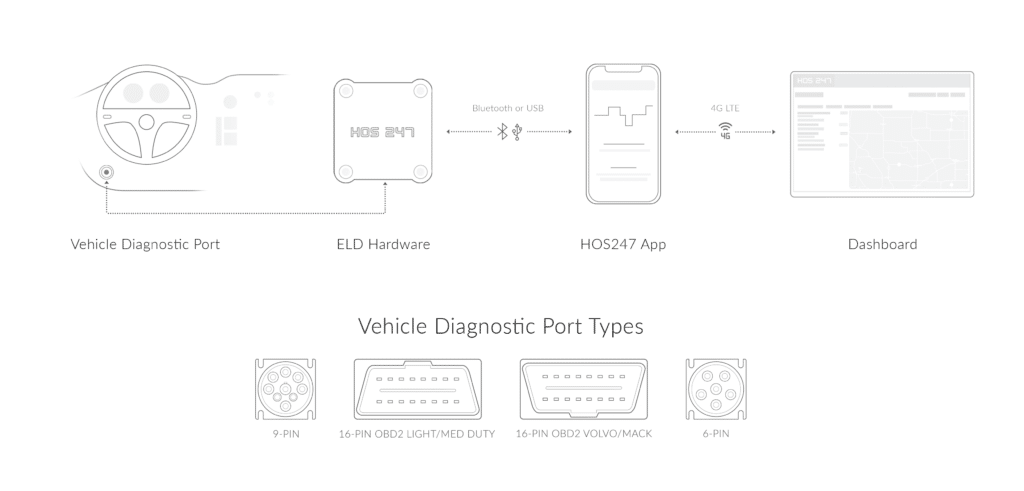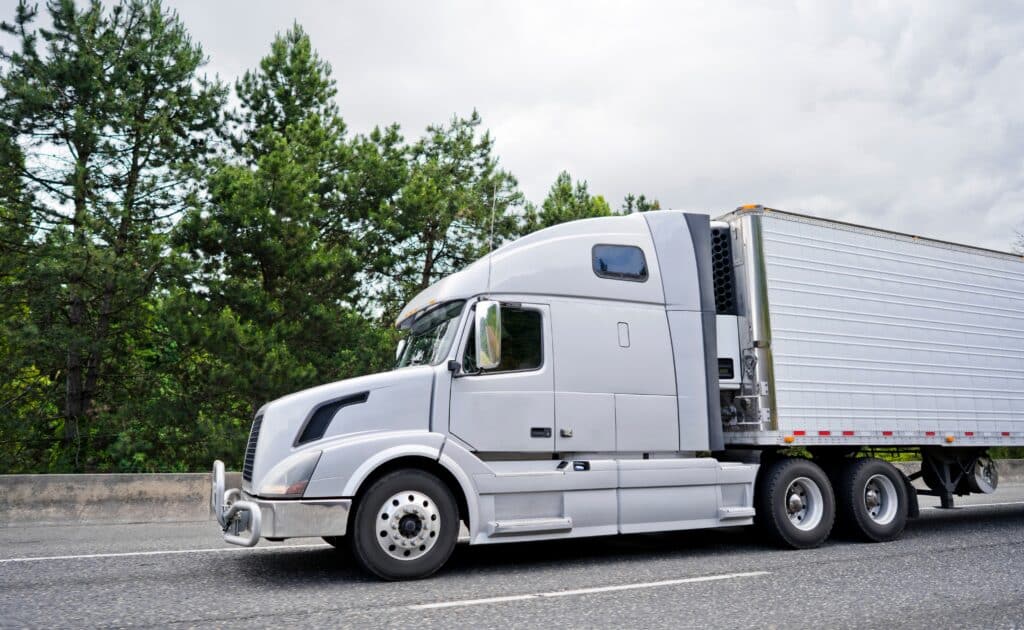For most trucking professionals, electronic logging devices (ELDs) are now standard equipment in the cab. These systems go far beyond simple hour-tracking tools. They serve as comprehensive compliance solutions that connect directly to a vehicle’s engine control module (ECM), automatically recording driving time, engine hours, vehicle movement, and miles driven with precision that paper logs simply cannot match.
The evolution from paper logs to AOBRDs and finally to electronic logs has transformed how trucking companies manage hours of service compliance. Today’s electronic logbooks synchronize with engine data to provide tamper-resistant records that satisfy Transport Canada requirements while offering valuable operational insights. They automatically capture changes in duty status, track vehicle locations at each change, and maintain accurate records that can be quickly accessed during roadside inspections.
Implementing the right ELD for trucking companies isn’t just about checking a compliance box — it’s about adopting technology that can streamline operations, reduce violations, and provide critical data for business decisions. While the mandate made ELDs necessary, the operational benefits have made them valuable tools for fleets focused on efficiency and profitability in an increasingly competitive industry.
Do you have any questions? Talk to ELD Advisor: 650-405-3372 or Request Callback
The Regulatory Landscape: Transport Canada Mandate and Its Implications
The Canadian ELD mandate is part of Canada’s efforts to enhance road safety and align with international standards for commercial vehicle operations. The regulation was published in the Canada Gazette in June 2019, with Transport Canada overseeing the implementation and enforcement of these rules.
After a phased implementation approach that included several enforcement deferrals, full compliance with the Canadian ELD mandate became mandatory for federally regulated carriers on January 1, 2023. The mandate applies to most motor carriers and drivers who are currently required to maintain daily logs. There are limited exceptions to this rule, such as:
- Commercial vehicles operated under a permit issued by a provincial or territorial authority.
- Commercial vehicles subject to a rental agreement with terms less than 30 days.
- Commercial vehicles manufactured before model year 2000.
- Commercial vehicles operating under specific exemptions granted by provincial or territorial authorities.
The implications of the mandate have been significant for the Canadian trucking industry. Non-compliance can result in serious penalties, including:
- Drivers being placed out of service.
- Potential fines (which vary by province).
- Negative impacts on a carrier’s safety rating.
- Increased scrutiny during roadside inspections and facility audits.
A key difference in the Canadian ELD mandate is the requirement for third-party certification of all ELD devices. Unlike the U.S. self-certification model, Canada requires all ELDs to be certified by accredited certification bodies to ensure they meet technical standards and cannot be tampered with.
While the transition required adjustment, many fleets have discovered benefits beyond compliance, including reduced paperwork, improved accuracy in record-keeping, and valuable data for fleet management and cross-border operations.

Importance of ELDs for Trucking Companies
While initially viewed as just a regulatory burden, electronic logging devices now deliver significant value beyond satisfying Transport Canada requirements. Modern ELDs have evolved into tools that enhance safety, streamline operations, and improve profitability for trucking companies of all sizes.
Ensuring Regulatory Compliance
For trucking companies, regulatory compliance isn’t optional—it’s essential. Electronic logbooks provide a straightforward path to meeting hours of service regulations without the paperwork burden. They create accurate, tamper-resistant records that satisfy provincial and federal requirements during roadside inspections.
During inspections, drivers can present clear, organized electronic records with just a few taps instead of sorting through paper logs. This saves time and reduces violations from logging errors.
Certified ELDs automatically track required data including date, time, location, engine hours, vehicle kilometers, identification information, and duty status changes. By maintaining these records automatically, they eliminate common violations like form errors, falsification, and missing information—resulting in fewer fines, better safety ratings, and reduced risk of service interruptions.
Enhancing Safety on the Road
ELDs promote safer driving by ensuring drivers follow required rest periods. The automatic logging prevents exceeding daily and weekly driving limits, reducing fatigue-related accident risks on highways.
These devices provide real-time alerts when drivers approach their hours limits, allowing them to find safe parking before reaching maximum driving time. This prevents situations where drivers might exceed limits due to poor planning or delivery pressure.
Many systems offer additional safety features like excessive speed alerts, maintenance notifications, break reminders, and documentation of driving behaviors. These benefits lead to fewer accidents, lower insurance costs, reduced liability, and an improved company reputation within the transportation industry.
Boosting Operational Efficiency
The operational efficiency gains from ELDs are substantial. By automating record-keeping and providing real-time data, these devices streamline fleet management in multiple ways.
Automation eliminates hours of paperwork for both drivers and office staff. Drivers focus on driving while administrative personnel handle more valuable tasks.
Real-time data enables better decision-making:
- Dispatchers see available hours for accurate load planning.
- Fleet managers receive alerts about delays or route deviations.
- Maintenance teams get engine diagnostic warnings before breakdowns.
- Billing departments access accurate delivery records for faster invoicing.
Many ELD systems also integrate with broader management solutions offering benefits like fuel optimization, improved customer service through accurate arrival predictions, better vehicle utilization, and reduced empty kilometers.
In the competitive trucking environment with tight margins, these efficiencies can determine success. By providing accurate data and automating routine tasks, ELDs help trucking companies operate more efficiently while maintaining compliance and improving safety.

Key Features to Consider When Choosing an ELD
Selecting the right electronic logging device affects your compliance, operations, and costs. With many options available, focus on these essential features to make a choice that works for your business:
Transport Canada Certification
Any ELD you consider must be certified by an accredited certification body approved by Transport Canada. This is a critical difference from the U.S. system, where self-certification is permitted. The certification ensures the device meets the technical standards established in Canada’s ELD mandate and cannot be tampered with. Verify that your chosen ELD appears on Transport Canada’s list of certified devices.
User-Friendly Interface
Drivers need an intuitive interface that doesn’t cause frustration. Look for clear displays visible in all lighting conditions with responsive touch screens and large buttons that work when wearing gloves. The best systems require minimal taps for common functions and clearly show available hours with warnings when approaching limits.
Hardware Reliability
ELD components must withstand the demanding truck environment, including Canada’s extreme weather conditions. Devices should handle vibration, temperature changes (including severe cold), and occasional bumps. Connection methods should maintain consistent links without disconnections that create logging gaps. Consider replacement costs and how the hardware mounts in the cab without obstructing views.
Integration Capabilities
Your ELD should work with your other systems, including:
- Transportation Management Systems.
- Fleet management software.
- Dispatch systems.
- Maintenance tracking.
- Fuel cards and expense tracking.
- Navigation solutions.
- Cross-border documentation systems for U.S.-Canada operations.
Good integration eliminates duplicate data entry and provides better operational visibility, particularly important for fleets operating in both Canadian and U.S. jurisdictions.
Support and Training Resources
Even user-friendly ELDs need support occasionally. Evaluate providers based on:
- Support availability.
- Multiple support channels.
- Response times.
- Training options.
- Quality documentation.
- Language options for drivers (including French for Quebec operations).
Providers offering dedicated setup assistance can make transitions much smoother.
Data Management and Reporting Tools
Look for systems that offer valuable reporting capabilities beyond basic logging, including violation alerts, performance metrics, and fuel tax reporting for both Canadian and cross-border operations. The ability to customize reports and easily access historical logs helps during audits and for resolving disputes. Cloud storage with automatic backups provides added security for your records.
Top ELD Options in the Market
Driver satisfaction plays an important role in successful ELD implementation. Solutions with high app store ratings typically offer better user experiences and fewer technical frustrations. Below is a comparison of current market leaders based on their mobile application ratings:
| RANK | ELD PROVIDER | iOS APPSTORE | ANDROID PLAYSTORE |
|---|---|---|---|
| 1 | |||
| 2 | KeepTruckin | ||
| 3 | JJ Keller | ||
| 4 | BigRoad | ||
| 5 | Rand McNally | ||
| 6 | |||
| 7 | PeopleNet | ||
| 8 | Verizon | ||
| 9 | Stoneridge |
These ratings reflect the day-to-day usability of each system, with higher scores typically indicating intuitive interfaces, reliable performance, and responsive support when issues arise. When evaluating your options, consider both the experiences of other trucking companies and how each solution aligns with your specific operational needs.
Benefits of HOS247 ELD for Trucking Companies
After reviewing the important factors in selecting an ELD, it’s worth examining a solution that consistently meets these requirements. HOS247 has built a strong reputation among drivers who need reliable equipment and practical support. Their approach focuses on real-world trucking needs rather than just technical specifications.
Here’s what makes HOS247 stand out:
- Reliability. We offer a quality solution with a stable Bluetooth connection that doesn’t drop during operation. This reliability prevents those frustrating data gaps that can lead to violations during inspections.
- Easy-to-use interface. The logbook app features large, clear buttons and straightforward navigation designed for drivers, not tech experts. Status changes require just a few taps, available hours are prominently displayed, and the daily log graph looks similar to paper logs for easy reference.
- Efficient support. When you call with an issue, you’ll speak with representatives who understand trucking, not just technology. Support is available in English, Spanish, Russian, or Polish seven days a week. If a call drops, we’ll call you back to finish resolving your issue instead of having you start over.
- Durable hardware. The physical ELD component is built specifically for the demanding environment of a truck cab. It withstands vibration, temperature extremes, and daily use without failure. Installation typically takes just minutes, without complex wiring or specialized tools.
- Compatibility. HOS247 works with both Android and iOS devices, allowing you to use the smartphone or tablet you already own and are comfortable with.
- No long-term commitments. Unlike providers that lock you into multi-year contracts, HOS247 offers month-to-month service options. This flexibility means you’re not stuck with a system that doesn’t meet your needs, and you can adapt as your business changes without facing steep early termination fees.
- Trial period. HOS247 provides a two-week trial period that allows you to test the system during actual routes and real driving conditions.
- Complete fleet management system. Beyond basic hours-of-service logging, HOS247 integrates features including automatic IFTA calculations by jurisdiction, real-time GPS tracking, electronic vehicle inspection reports, and maintenance scheduling.
If you’ve experienced frustration with ELDs that complicate rather than simplify compliance, HOS247 offers a worthwhile alternative. Whether you’re selecting your first ELD or replacing an unsatisfactory system, HOS247 provides technology that supports your operation instead of creating additional challenges.
Fleet Size and Operational Considerations
The scale and nature of your operation significantly influences which ELD solution will provide the best fit. Small owner-operators face different challenges than large fleets with hundreds of vehicles, and the ideal solution varies accordingly.
For Small Fleets and Owner-Operators:
- Cost-effectiveness becomes particularly critical as the investment represents a larger percentage of operating expenses.
- Simplicity and ease of use often take priority over advanced features.
- Self-installation options can reduce implementation costs.
- BYOD compatibility may allow use of existing smartphones or tablets.
- Minimal administrative overhead is preferable.
For Medium and Large Fleets:
- Robust administrative portals become essential for managing multiple drivers and vehicles.
- Role-based access controls allow different departments to access relevant information.
- Bulk processing capabilities streamline tasks like log auditing and corrective actions.
- Advanced reporting features provide insights into fleet-wide trends.
- Integration with existing enterprise systems becomes more valuable.
- Training and implementation support take on greater importance.
Special Operational Needs:
- Regional vs. long-haul operations may require different feature sets.
- Teams operating between provinces or cross-border into the U.S. need compliance with multiple regulations.
- Fleets operating under multiple rule sets need flexibility in compliance settings.
- Specialized operations like hazardous materials transport may have additional documentation requirements.
Understanding how these factors align with various ELD offerings helps narrow down the options to those that truly fit your operational profile in the Canadian market.

Common Challenges with ELD Implementation
Adopting a new ELD system involves navigating several common hurdles. Understanding these challenges before implementation can help trucking companies prepare effectively and minimize disruptions to their operations.
Technical Issues and Solutions
Even the best ELD systems occasionally experience technical difficulties. Common problems include Bluetooth connectivity issues, data synchronization failures, and app crashes. When these issues occur during critical operations or inspections, they can create significant stress for drivers.
Preventative measures can reduce the frequency and impact of technical problems:
- Ensure proper installation by following manufacturer guidelines exactly.
- Keep both the ELD app and your mobile device’s operating system updated.
- Document connection procedures so drivers can troubleshoot basic issues.
- Test the system thoroughly before relying on it for compliance.
- Establish a clear process for drivers to report technical issues.
- Keep paper logs available as backup during the initial implementation period.
Most importantly, choose an ELD provider with responsive technical support. The ability to quickly reach knowledgeable representatives can transform a potential violation into a minor inconvenience. Providers that offer support Monday through Sunday are particularly valuable for operations that run around the clock and across multiple time zones.
Overcoming Driver Resistance
Driver acceptance is often the most significant factor in successful ELD implementation. Many experienced drivers have understandable concerns about new technology, particularly systems that track their activities. Common objections include privacy concerns, fear of unfair monitoring, difficulty learning new technology, and worry about losing productivity during the adjustment period.
Addressing these concerns requires a thoughtful approach:
- Involve drivers in the selection process to give them a sense of ownership.
- Emphasize how the ELD will make their jobs easier by eliminating paperwork.
- Provide clear information about what data is collected and how it will be used.
- Acknowledge the learning curve and reassure drivers they’ll have time to adjust.
- Show how the ELD can protect drivers from being pressured to violate hours rules.
- Use peer training where drivers who adapt quickly help those who struggle.
Most resistance diminishes once drivers become comfortable with the system and discover the benefits of electronic logging. Many drivers who initially opposed ELDs later report they wouldn’t want to return to paper logs, particularly as they experience fewer form and manner violations and more accurate record-keeping.
Effective Training Strategies
Comprehensive training significantly reduces implementation problems and accelerates user adoption. The most effective training approaches include:
- Hands-on practice sessions with actual devices.
- Scenario-based training that covers common situations drivers will encounter.
- Small group sessions that allow for individual questions.
- Written quick-reference guides drivers can keep in their trucks.
- Short video tutorials focusing on specific tasks.
- Refresher training after drivers have used the system for a few weeks.
Training should cover not only basic operations but also troubleshooting steps and procedures for handling special situations like team driving, personal conveyance, and yard moves. Fleet managers and administrative staff will need separate training focused on the back-office aspects of the system, including running reports, monitoring compliance, and managing driver accounts.
How to Successfully Transition to a New ELD Provider
Many fleets find themselves needing to switch ELD providers due to reliability issues, poor support, or changing operational needs. Planning this transition carefully minimizes disruptions and compliance risks.

Evaluating the Need for a Change
Before undertaking the effort of switching providers, carefully assess whether a change is truly necessary. Clear indicators that it’s time to switch include:
- Persistent technical problems that affect compliance.
- Poor customer service that leaves issues unresolved.
- Missing features that impact operational efficiency.
- Driver complaints about usability issues.
- Rising costs without corresponding value.
- The current provider no longer having Transport Canada certification.
Distinguish between problems that can be resolved through additional training or configuration changes and those that are inherent to the system itself. Sometimes a conversation with your current provider about your concerns can resolve issues without a complete system change.
If you determine a switch is necessary, begin the process well before your current contract renewal date. This provides adequate time for research, implementation, and training without pressure to make a hasty decision.
Steps for a Smooth Transition
Successfully moving from one ELD provider to another requires careful planning and execution:
- Research and selection. Thoroughly evaluate potential providers, checking Transport Canada certification status, reading reviews, and requesting demonstrations. Consider getting input from drivers who will use the system daily.
- Implementation planning. Create a detailed transition timeline that includes hardware installation, training sessions, and a gradual rollout if possible. Assign clear responsibilities for each aspect of the transition.
- Data preservation. Ensure you have access to historical logs before deactivating your old system. Download and securely store records that may be needed for audits or tax purposes.
- Overlapping systems. If possible, run both old and new systems simultaneously for a short period. This provides a safety net while drivers become familiar with the new system.
- Driver training. Schedule comprehensive training sessions before the switch. Focus on differences between the old and new systems to help drivers adapt more quickly.
- Communication. Keep all stakeholders informed throughout the process. Clear communication reduces anxiety and prevents misunderstandings about expectations.
- Support readiness. Ensure additional support is available immediately after the switch when questions and issues are most likely to arise.
Avoiding Downtime and Compliance Risks
The transition period presents heightened risks for both operational disruptions and compliance violations. Minimize these risks with these practical strategies:
- Schedule the actual switchover during slower operational periods if possible.
- Ensure drivers understand how to operate both systems during the transition.
- Create clear procedures for handling roadside inspections during the changeover.
- Maintain open communication with your new provider about any issues that arise.
- Consider bringing in additional temporary help for the transition period.
- Monitor logs closely during the first few weeks to catch and correct any errors.
- Prepare drivers with paper log backups in case of unexpected technical issues.
Remember that even with perfect planning, some challenges will likely arise during the transition. Maintaining flexibility and a problem-solving attitude will help your team navigate the change successfully.

Conclusion
Selecting the right ELD for your trucking operation goes beyond meeting regulatory requirements. The ideal solution delivers reliability first, with an interface that drivers can easily navigate and support that resolves issues quickly.
While features and price matter, the true value comes from systems that reduce administrative burdens while providing accurate compliance. Take time to research thoroughly, test systems in real-world conditions, and speak with current users before making your decision.
The right ELD for trucking companies should simplify operations rather than complicate them. Whether you’re implementing your first system or switching providers, focus on solutions that address your specific operational needs while offering the stability to adapt as regulations evolve. With careful selection, your electronic logbook can become a valuable asset that enhances safety, efficiency, and your bottom line in the transportation industry.

As an expert in B2B and B2C sales, I’ve dedicated myself to perfecting sales processes and client retention strategies in the logistics and trucking industry. I have significantly contributed to the expansion of the ELD service, catering to retail and wholesale clients in need of HOS247 ELD solutions. My unwavering commitment to implementing state-of-the-art sales techniques and technologies ensures the continuous growth and success of businesses I work with.












Hours of service records have been a part of truckers’ jobs for many years. Paper logbooks have been the way to keep records of duty status since HOS rules became law. Drivers manually record the data on a sheet, which

How to Do a Truck Driver Log Book: Simplify Compliance with the Right ELD in Canada A trucker’s log book is a vital document that provides a detailed account of a CMV driver’s activities within a 24-hour period. In accordance

For businesses in the transportation industry, compliance with the HOS regulations established by Transport Canada is not optional, it is a legal requirement. Before the implementation of the ELD mandate, truckers were allowed to record their hours of service manually